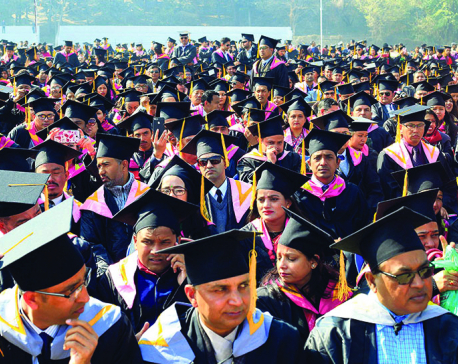
OR
Investing in knowledge
Published On: November 8, 2017 01:00 AM NPT By: Raju Adhikari, Pramod Dhakal, Drona Rasali & Ambika Adhikari

Raju Adhikari, Pramod Dhakal, Drona Rasali & Ambika Adhikari
The authors are associated with Non-Resident Nepali Association’s Skill Knowledge and Innovation (SKI) Committeenews@myrepublica.com
More from Author
Our educational and science and technology policies have failed to keep up with global pace of technological advancement and we have no strategy to catch up.
Nepal has had a late start in science and technology (S&T). As a result of Rana rulers’ closed-door policy, Nepal has left out of the social transformation the rest of the world was undergoing due to the industrial revolution. This historical legacy has hampered the country’s progress in S&T education.
Nepal’s first S&T policy was drafted in 1961 with the help of UNESCO. The UN body had recommended setting up separate government Research and Development (R&D) departments, which subsequently led to establishment of the Royal Drug Research and Agricultural Departments. Tribhuvan University’s Research Center for Science and Technology (RECAST) was established in 1977 and, almost a decade later, Nepal Academy of Science and Technology (NAST, then RONAST) came into being in 1982 to coordinate overall S&T activities.
In 1992, the Nepal Agricultural Research Council (NARC) was established and the National Planning Commission set up a separate science unit. Later the same year, Government of Nepal established the Ministry of Science and Technology (MoST) to consolidate and modernize S&T activities and bring them under one umbrella ministry.
In this 70-year span, Nepal’s S&T policy moved slow and funding was poor. It failed to make any impact on public perception about the importance of education and S&T while government funding was poor, barely 0.11-0.3 percent of GDP. But in this time literacy increased from 10 percent to 67 percent; more importantly, female literacy went up to 56 percent. But school and college dropout rates remain high, at almost 30 percent; and 20 percent of the marginalized communities still do not have access to basic science education.
Of the 29 million people in Nepal, less than 200,000 have post-graduate (or higher) education. Meanwhile, the World Trade Organization (WTO) predicts that by 2020, 40 percent of global employment in any industry would need at least undergraduate degree.
Leaving in droves
Nepal’s youth is leaving the country in large numbers (with 30 percent annual increase) in search of higher education. Similarly, highly-skilled manpower is also leaving in search of better life. This creates a huge vacuum and Nepal does not have enough skilled human resources to meet growing industry needs. Private sector can always access cheap manpower from neighboring countries. But weakening of the public sector may exacerbate disparities between rich and poor in an already unequal society. As private sector cannot absorb the majority of human resources, the public sector remains the largest employer in the skilled sector.
Nepal needs to drastically increase the budget for education and S&T. In this, increased investment and contributions of the private sector is important. Our education and S&T policies have failed to recognize the global pace of technological advancement, and the country has not developed strategies to catch up. In comparison to S&T, education has experienced huge growth as a profitable business in the past two decades, driven by private investment.
However, the policies, priorities and financial commitments to lift school education standards, and access, are sub-par. GoN educational and S&T agencies need strong partnership and co-investment, with NRNA as a potential partner.
NRNA has become a powerful diaspora organization with 76 chapters and 70,000 members representing a 3.5 million-strong diaspora population. NRNA’s knowledge investment initiative in the Skill Knowledge and Innovation (SKI) taskforce, formed nine years ago to utilize skills, knowledge, innovation and experiences of diaspora for Nepal, was a progressive step. But NRNA has been unable to play the role of real partners in development projects.
What Nepal needs
Since its establishment in 2009, the SKI committee has been able to develop close links with Nepal’s S&T institutions and diaspora professional associations and develop strategic directions.
SKI flagship project concepts are aligned with Nepal’s priorities. Two major flagship projects launched by NRNA in SKI initiatives so far have been Open University of Nepal Initiative (OUNI) and Nepal Science Foundation Trust (NSFT). Only recently, the Road Safety Project is being approved as another flagship project. Along with these major initiatives, other long-term projects such as SKI inventory of Diaspora professionals and Annual SKI Brain Drain Seminar series are also among SKI’s core programs.
The Open University Initiative (OUNI) led by Project Champion Pramod Dhakal since 2009 concluded successfully with the establishment of Open University Nepal. NRN OUNI team developed its white paper in consultation with GoN and after almost eight years, Open University 2073 Act was finally passed and Open University established under government ownership.
NRNA can provide a forum to skilled diaspora to unite and contribute in this visionary project. However, in order to fully realize the diaspora contribution to the Open University, the government should have diaspora-friendly university policies, so that they can be accommodated at both academic and government levels.
Mission 2030
Similarly, the Nepal Science Foundation (NSF) has been registered as a trust in Nepal following the NRN Declaration in 2013. The NSF aims to campaign for science teaching in schools and at tertiary level through science-based projects. It is intended to ensure greater awareness on science at the community level and promotion of indigenous technology.
Since 2012, SKI Brain Drain Seminar provides an interactive forum for Nepalis and diaspora professionals to share and develop R&D networking in order to support scholar exchange and collaborative projects. Likewise, Skill Inventory program led by Europe SKI team (Lok Raj Sharma) aims to establish a repository of NRN’s academic and professional information online to get NRNs to effectively coordinate and utilize such resources for national development.
Besides these, there are projects in biotechnology, health and agriculture, most notably the initiative by the Korea SKI team of Dr Devi Basnet on co-investment model. This is intended at adding value to our native plants, which have a huge potential demand in cosmetic and pharmaceutical industries. However, investing in knowledge is a future investment and NRNA needs a long-term strategic policy and commitment, as most SKI projects are non-profits.
During the NRN global conference this year, NRNA SKI and Youth committees and Nepal Youth Council jointly organized a one-day workshop and interactive session on the role of Science Technology and Information (STI) for youth empowerment and country’s development. NRNA has included some recommendations in NRN declaration and Vision 2020 (and beyond), with a commitment to make SKI play a major role in knowledge investment. This is important when the government is preparing a new STI policy to support the country’s Vision 2030.
The authors are associated with Non-Resident Nepali Association’s Skill Knowledge and Innovation (SKI) Committee
You May Like This

Saraswati Puja being observed today
KATHMANDU, Feb 16: Shree Panchami, also known as Basanta Panchami or Saraswati Puja, is being celebrated across the country by... Read More...

Transformation in teaching
For realizing the changes, our universities must shift some weight of teaching to learning, knowledge to skills, exams to... Read More...





Just In
- Nepalgunj ICP handed over to Nepal, to come into operation from May 8
- Nepal to gift two elephants to Qatar during Emir's state visit
- NUP Chair Shrestha: Resham Chaudhary, convicted in Tikapur murder case, ineligible for party membership
- Dr Ram Kantha Makaju Shrestha: A visionary leader transforming healthcare in Nepal
- Let us present practical projects, not 'wish list': PM Dahal
- President Paudel requests Emir of Qatar to initiate release of Bipin Joshi
- Emir of Qatar and President Paudel hold discussions at Sheetal Niwas
- Devi Khadka: The champion of sexual violence victims



_20240423174443.jpg)










Leave A Comment